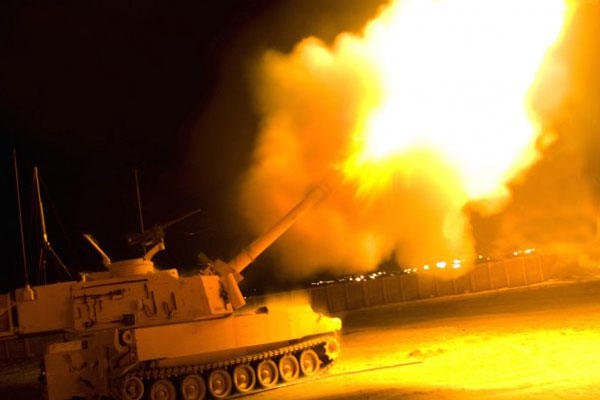The U.S. Army is asking defense firms to develop prototypes for a new, lightweight artillery muzzle brake that's designed to work with the service's future extended-range cannons.
The Army has made long-range precision fires its top modernization priority under a bold plan to field new, more capable weapons systems by 2028.
In the short term, Army artillery experts are working to develop a 155 mm cannon capable of striking targets to 70 kilometers, a range that doubles the effectiveness of current 155s.
As part of this effort, the Army recently asked the defense industry to develop "novel muzzle brake structures for extended range cannon artillery systems" that are 30 percent lighter than conventional muzzle brakes, according to a solicitation posted on www.sibr.gov, a government website for the Small Business Innovation Research (SBIR) program.
"Given the Army's Long Range Precision Fires priority, a need exists for novel and innovative muzzle brakes capable of supporting the new extended range cannons and sabot, direct, and indirect munitions currently under development," the solicitation states.
"High pressure waves produced within gun barrels during projectile acceleration have negative impact upon the surrounding environment due to muzzle blast ... exiting the barrel," it adds.
Muzzle brakes are also subjected to "material degradation due to collisions with small particles exiting the gun barrel, such as solid propellant grains that did not undergo combustion," the solicitation states.
Because of this, current muzzle brakes tend to be heavy.
The effort "seeks to develop novel muzzle brake aerodynamic designs and structures which minimize the overall mass of the artillery system without compromising performance," according to the solicitation.
Interested companies have until Feb. 6 to respond to the Nov. 28 solicitation.
The first phase of the solicitation asks companies to model and simulate the operational performance of proposed muzzle brake designs that meet the weight-reduction requirements and simulate mechanical wear over the life cycle of the brake.
Companies will then produce at least one prototype for Phase Two, which will be tested on a large-caliber Army platform identified during the Phase One effort, according to the solicitation. Companies will document "recoil, acoustic and optical signature, and muzzle blast" and make refinements on the prototype design, it says.
Companies then will conduct a live-fire demonstration of their final prototype in an operational environment with involvement from the prime contractor for the weapon system, according to the solicitation.
Meanwhile, under the Extended Range Cannon Artillery program, or ERCA, the Army plans to fit M109A8 155 mm Paladin self-propelled howitzers with much longer, .58 caliber gun tubes, redesigned chambers and breeches that will be able to withstand the gun pressures to get out to 70 kilometers, Army officials said.
The service also is finalizing a new version of a rocket-assisted projectile (RAP) round that testers have shot out to 62 kilometers. Artillery experts plan to make improvements to the round by fiscal 2020 so Army testers can hit the 70-kilometer mark, service officials said at the 2018 Association of the United States Army annual meeting and exposition.
-- Matthew Cox can be reached at matthew.cox@military.com.










